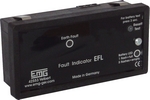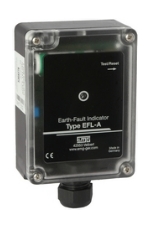Earth-fault indicator
Type EFL
The earth-fault indicator type EFL can be used in radial medium voltage networks with one input and open-ring networks. The network has to be solidly earthed or low resistance-earthed. The earth-fault is indicated by an LED. The sensor and the display unit are connected by cable. The sensor must be mounted on screened cables. It is divisible and can be retrofitted on the cable. The display device is powered by an exchangeable lithium battery. The earth-fault indicator type EFL can reset automatically by recovering 230V AC.
The earth-fault indicator type EFL consists of:
– One display unit with cable for displaying the earth-fault
– One earth-fault sensor type SE with terminal connection for detecting the earth-fault
The indicator is available in three versions:
| Version | basic | scada | plus |
| Fixed functional values: trip current, response delay, reset time |
X | X | |
| Adjustable functional values: trip current, response delay, reset time |
X | ||
| automatic reset by 230V AC | X | X | X |
| automatic reset by network current | X | ||
| remote indication (permanent contact) | X | ||
| remote contact (permanent and wipe contact) | X | ||
| remote reset | X | X | |
| connection for external blinking lamp | X |
| Order Data | Article no. | |
| Type EFL basic | | panel-mounted | 27.21.10 |
| Type EFL scada | | panel-mounted | 27.22.10 |
| Type EFL plus | | panel-mounted | 27.23.10 |
| Type EFL basic | | surface-mounted | 27.31.10 |
| Type EFL scada | | surface-mounted | 27.32.10 |
| Type EFL plus | | surface-mounted | 27.33.10 |



